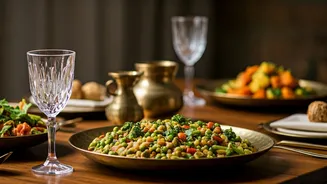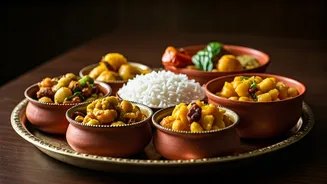Mindful Eating Practices
The first ritual centers on the principle of mindful eating, a practice that encourages individuals to savor each bite and pay close attention to the sensations
of eating. This involves removing distractions, such as television or smartphones, and focusing on the appearance, aroma, and taste of the food. Eating slowly allows for improved digestion, as the body can better prepare for the intake of nutrients. This practice also boosts awareness of hunger and fullness cues, assisting in the prevention of overeating. By fostering a sense of appreciation for the meal and where it originated from, this method encourages a calmer, more pleasant, and rewarding eating experience. Such awareness also highlights the social and cultural contexts of food consumption, strengthening the connection between food and well-being.
Respecting Food Origins
The second ritual encourages showing respect for the origin of food. This involves acknowledging the efforts of farmers, the natural resources, and the journey that food undertakes to arrive on one's plate. This gratitude is often expressed through a silent prayer or mantra, a gesture of appreciation before starting the meal. It is also an understanding of the impact of one's eating habits on the environment. This ritual cultivates a sense of respect, minimizing food waste, and making individuals more conscious of sustainable eating practices. By connecting to the food chain, people establish a deeper understanding of the significance of their meals, encouraging greater mindfulness and responsibility in their food choices. This also leads to a more comprehensive view of food's value and how it aligns with the values of sustainability and environmental stewardship.
Sattvic Food Principles
The third ritual embraces the principles of Sattvic food. Sattvic foods are characterized by their purity, freshness, and ease of digestion, which promote mental clarity, emotional balance, and physical health. This involves prioritizing fresh fruits, vegetables, whole grains, and legumes while avoiding processed foods, excessive spices, and stimulants. Sattvic eating is closely linked to Ayurveda, an ancient Indian medical system, and is believed to have a calming effect on the mind and body. This practice supports improved energy levels, better sleep patterns, and reduced stress. Moreover, a diet centered on Sattvic foods encourages a deeper awareness of the connection between diet and overall well-being. This, in turn, helps establish a harmonious relationship with food, assisting people in attaining a balanced and fulfilling life.
Eating at Set Times
The fourth ritual emphasizes maintaining regular meal times. In Indian tradition, eating meals at scheduled times is believed to support the body's natural rhythms. This practice aids in establishing a consistent digestive system and helps maintain stable blood sugar levels. By eating regularly, the body can better anticipate and efficiently process food. This structured method also prevents overeating, as it makes sure that the body receives timely nourishment. Regular meals help in the reduction of unhealthy food cravings and the temptation to snack on less-nutritious foods. Overall, regular meal timings aid in the promotion of a healthier lifestyle and more effective body function. This consistency also fosters a sense of discipline and supports an organized approach to daily life.
Sharing Meals Together
The fifth ritual underscores the significance of sharing meals with family and friends. This communal approach strengthens bonds and promotes social connections, which are crucial for mental and emotional well-being. Sharing meals together creates an atmosphere of closeness, which facilitates effective communication and the sharing of experiences. It is also an opportunity to experience diverse culinary traditions and to expand one's cultural awareness. Eating together nurtures a sense of belonging and strengthens the social fabric, supporting overall contentment and happiness. Sharing food is not just about nutrition; it's about sharing a part of one's self. By prioritizing communal meals, individuals can foster stronger relationships, enjoy food more fully, and create positive memories.













